Project Management: Risk, Revenue, and PMBOK Analysis Report
VerifiedAdded on 2023/01/13
|10
|2114
|44
Report
AI Summary
This report provides a comprehensive overview of project management principles, as applied to a case study involving Uber. It begins by introducing the PMBOK (Project Management Body of Knowledge) and its importance in the project lifecycle, covering key processes and knowledge areas. The report then explores project selection methods, focusing on risk and revenue considerations, and their impact on project success. It delves into ten crucial areas of project management, including project integration, scope, cost, human resources, communication, risk, procurement, and stakeholder management. Additionally, the report examines the initiative document, including the project charter and the identification of project stakeholders. The Uber case study is analyzed, focusing on the redesign of their driver application and its implications. The report concludes by emphasizing the growing importance of project management as a profession and its role in achieving project goals and organizational objectives.
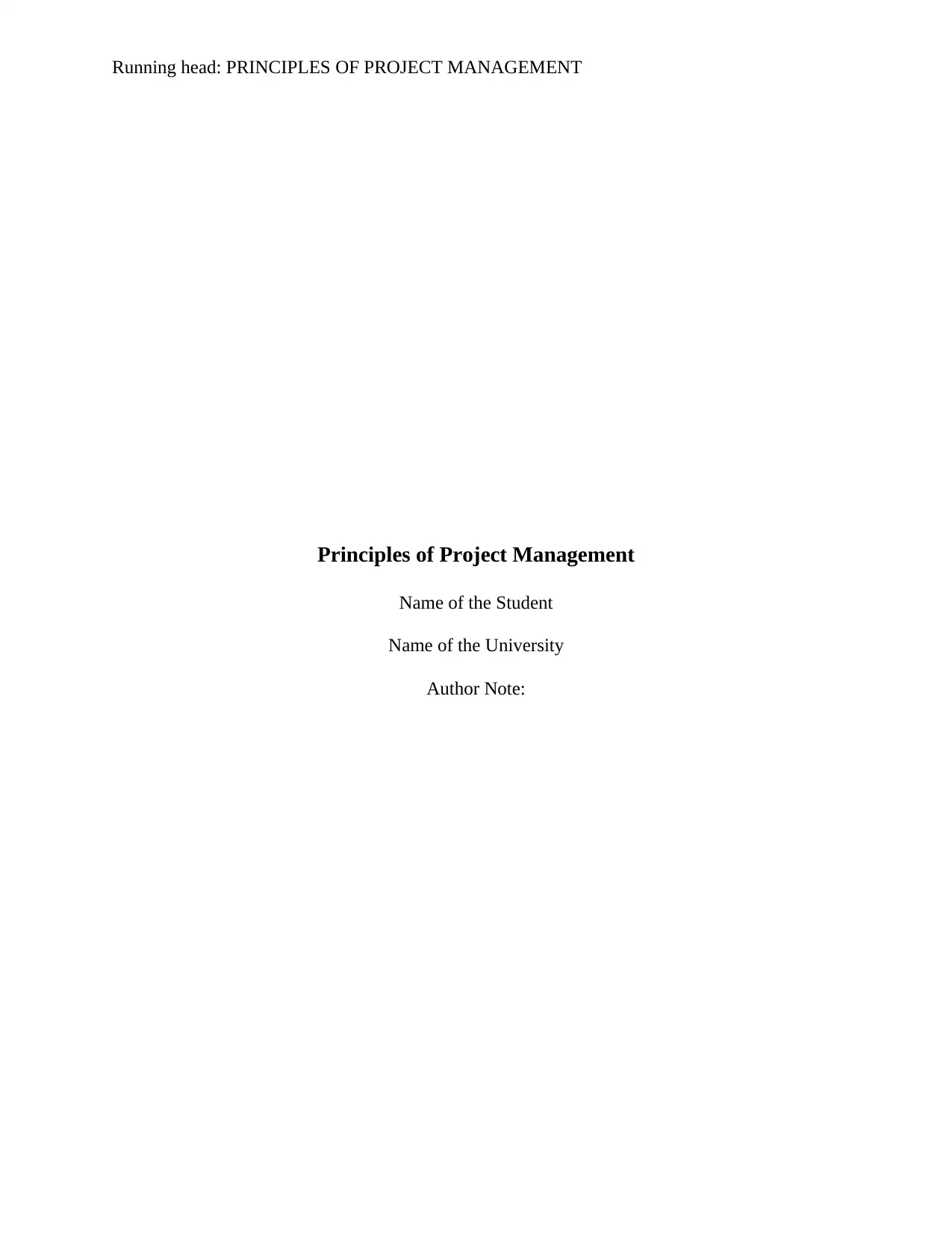
Running head: PRINCIPLES OF PROJECT MANAGEMENT
Principles of Project Management
Name of the Student
Name of the University
Author Note:
Principles of Project Management
Name of the Student
Name of the University
Author Note:
Paraphrase This Document
Need a fresh take? Get an instant paraphrase of this document with our AI Paraphraser
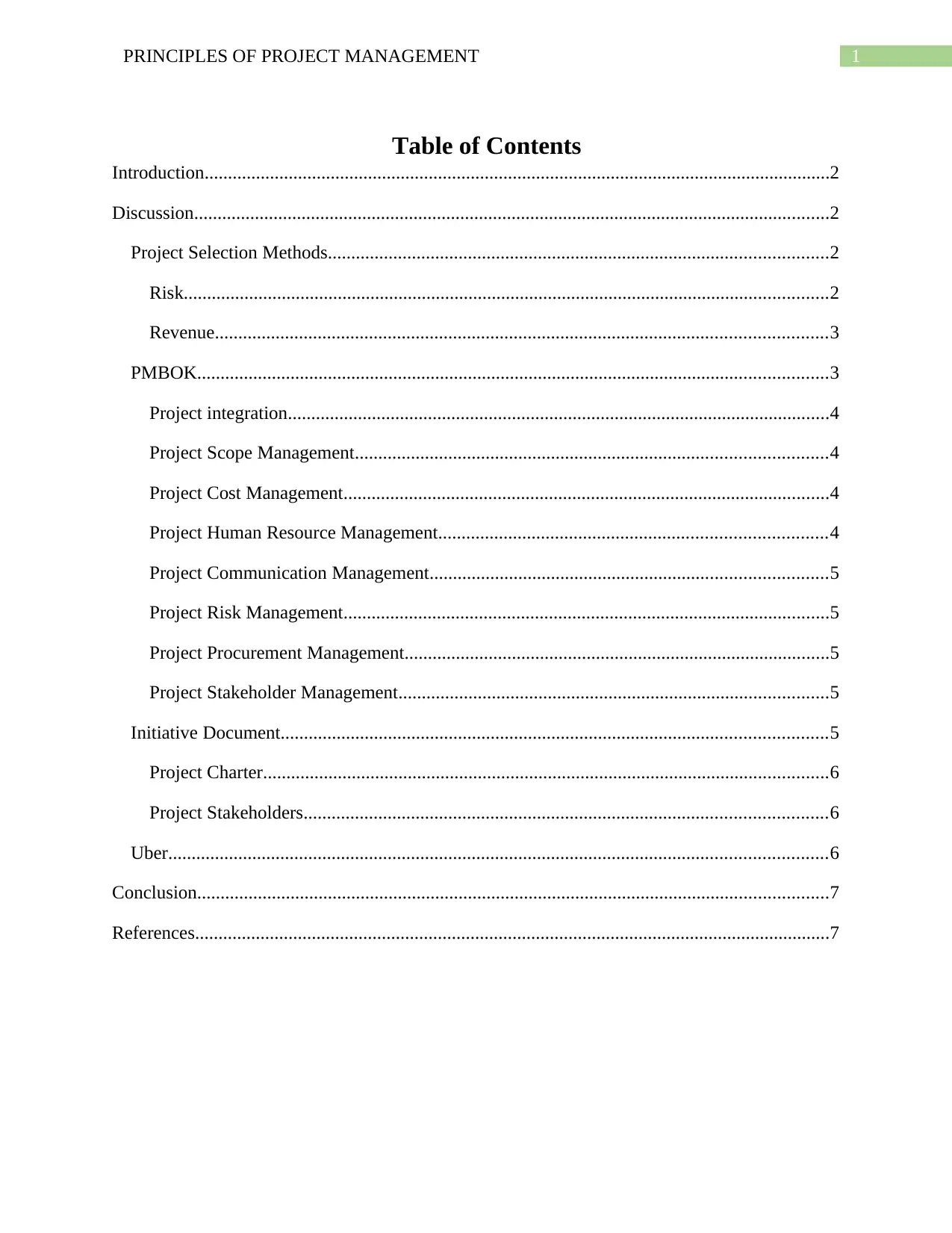
1PRINCIPLES OF PROJECT MANAGEMENT
Table of Contents
Introduction......................................................................................................................................2
Discussion........................................................................................................................................2
Project Selection Methods...........................................................................................................2
Risk..........................................................................................................................................2
Revenue...................................................................................................................................3
PMBOK.......................................................................................................................................3
Project integration....................................................................................................................4
Project Scope Management.....................................................................................................4
Project Cost Management........................................................................................................4
Project Human Resource Management...................................................................................4
Project Communication Management.....................................................................................5
Project Risk Management........................................................................................................5
Project Procurement Management...........................................................................................5
Project Stakeholder Management............................................................................................5
Initiative Document.....................................................................................................................5
Project Charter.........................................................................................................................6
Project Stakeholders................................................................................................................6
Uber.............................................................................................................................................6
Conclusion.......................................................................................................................................7
References........................................................................................................................................7
Table of Contents
Introduction......................................................................................................................................2
Discussion........................................................................................................................................2
Project Selection Methods...........................................................................................................2
Risk..........................................................................................................................................2
Revenue...................................................................................................................................3
PMBOK.......................................................................................................................................3
Project integration....................................................................................................................4
Project Scope Management.....................................................................................................4
Project Cost Management........................................................................................................4
Project Human Resource Management...................................................................................4
Project Communication Management.....................................................................................5
Project Risk Management........................................................................................................5
Project Procurement Management...........................................................................................5
Project Stakeholder Management............................................................................................5
Initiative Document.....................................................................................................................5
Project Charter.........................................................................................................................6
Project Stakeholders................................................................................................................6
Uber.............................................................................................................................................6
Conclusion.......................................................................................................................................7
References........................................................................................................................................7
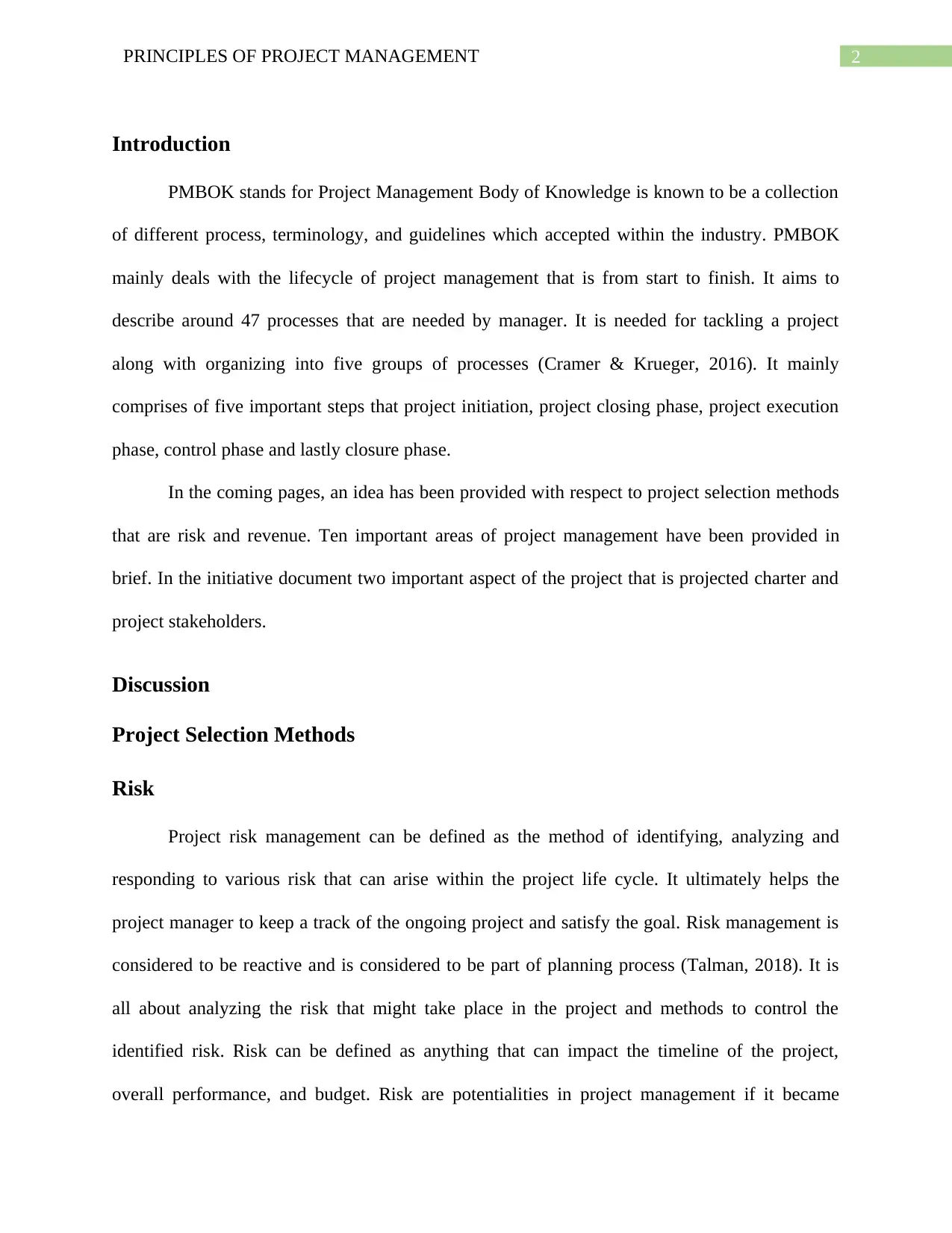
2PRINCIPLES OF PROJECT MANAGEMENT
Introduction
PMBOK stands for Project Management Body of Knowledge is known to be a collection
of different process, terminology, and guidelines which accepted within the industry. PMBOK
mainly deals with the lifecycle of project management that is from start to finish. It aims to
describe around 47 processes that are needed by manager. It is needed for tackling a project
along with organizing into five groups of processes (Cramer & Krueger, 2016). It mainly
comprises of five important steps that project initiation, project closing phase, project execution
phase, control phase and lastly closure phase.
In the coming pages, an idea has been provided with respect to project selection methods
that are risk and revenue. Ten important areas of project management have been provided in
brief. In the initiative document two important aspect of the project that is projected charter and
project stakeholders.
Discussion
Project Selection Methods
Risk
Project risk management can be defined as the method of identifying, analyzing and
responding to various risk that can arise within the project life cycle. It ultimately helps the
project manager to keep a track of the ongoing project and satisfy the goal. Risk management is
considered to be reactive and is considered to be part of planning process (Talman, 2018). It is
all about analyzing the risk that might take place in the project and methods to control the
identified risk. Risk can be defined as anything that can impact the timeline of the project,
overall performance, and budget. Risk are potentialities in project management if it became
Introduction
PMBOK stands for Project Management Body of Knowledge is known to be a collection
of different process, terminology, and guidelines which accepted within the industry. PMBOK
mainly deals with the lifecycle of project management that is from start to finish. It aims to
describe around 47 processes that are needed by manager. It is needed for tackling a project
along with organizing into five groups of processes (Cramer & Krueger, 2016). It mainly
comprises of five important steps that project initiation, project closing phase, project execution
phase, control phase and lastly closure phase.
In the coming pages, an idea has been provided with respect to project selection methods
that are risk and revenue. Ten important areas of project management have been provided in
brief. In the initiative document two important aspect of the project that is projected charter and
project stakeholders.
Discussion
Project Selection Methods
Risk
Project risk management can be defined as the method of identifying, analyzing and
responding to various risk that can arise within the project life cycle. It ultimately helps the
project manager to keep a track of the ongoing project and satisfy the goal. Risk management is
considered to be reactive and is considered to be part of planning process (Talman, 2018). It is
all about analyzing the risk that might take place in the project and methods to control the
identified risk. Risk can be defined as anything that can impact the timeline of the project,
overall performance, and budget. Risk are potentialities in project management if it became
⊘ This is a preview!⊘
Do you want full access?
Subscribe today to unlock all pages.

Trusted by 1+ million students worldwide
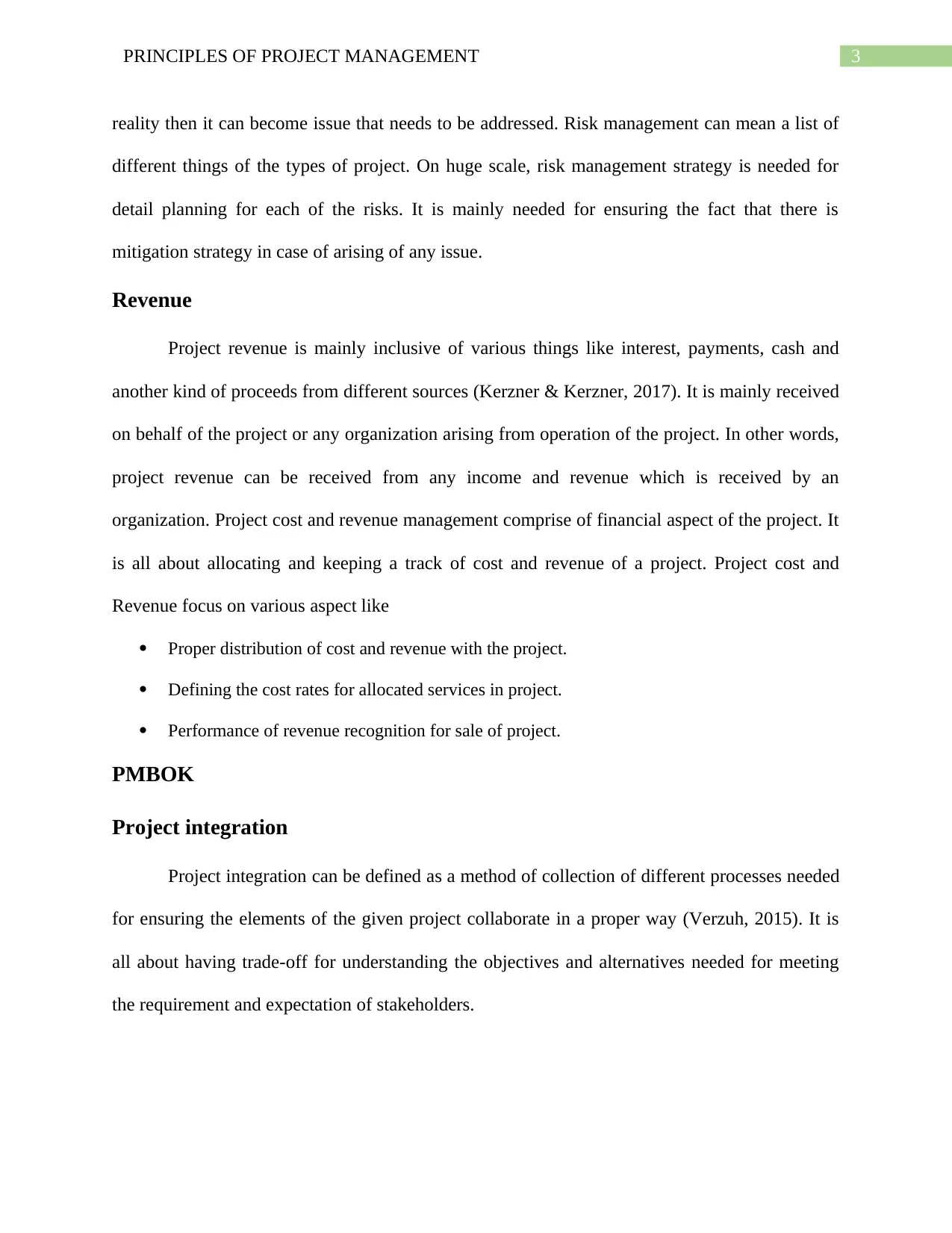
3PRINCIPLES OF PROJECT MANAGEMENT
reality then it can become issue that needs to be addressed. Risk management can mean a list of
different things of the types of project. On huge scale, risk management strategy is needed for
detail planning for each of the risks. It is mainly needed for ensuring the fact that there is
mitigation strategy in case of arising of any issue.
Revenue
Project revenue is mainly inclusive of various things like interest, payments, cash and
another kind of proceeds from different sources (Kerzner & Kerzner, 2017). It is mainly received
on behalf of the project or any organization arising from operation of the project. In other words,
project revenue can be received from any income and revenue which is received by an
organization. Project cost and revenue management comprise of financial aspect of the project. It
is all about allocating and keeping a track of cost and revenue of a project. Project cost and
Revenue focus on various aspect like
Proper distribution of cost and revenue with the project.
Defining the cost rates for allocated services in project.
Performance of revenue recognition for sale of project.
PMBOK
Project integration
Project integration can be defined as a method of collection of different processes needed
for ensuring the elements of the given project collaborate in a proper way (Verzuh, 2015). It is
all about having trade-off for understanding the objectives and alternatives needed for meeting
the requirement and expectation of stakeholders.
reality then it can become issue that needs to be addressed. Risk management can mean a list of
different things of the types of project. On huge scale, risk management strategy is needed for
detail planning for each of the risks. It is mainly needed for ensuring the fact that there is
mitigation strategy in case of arising of any issue.
Revenue
Project revenue is mainly inclusive of various things like interest, payments, cash and
another kind of proceeds from different sources (Kerzner & Kerzner, 2017). It is mainly received
on behalf of the project or any organization arising from operation of the project. In other words,
project revenue can be received from any income and revenue which is received by an
organization. Project cost and revenue management comprise of financial aspect of the project. It
is all about allocating and keeping a track of cost and revenue of a project. Project cost and
Revenue focus on various aspect like
Proper distribution of cost and revenue with the project.
Defining the cost rates for allocated services in project.
Performance of revenue recognition for sale of project.
PMBOK
Project integration
Project integration can be defined as a method of collection of different processes needed
for ensuring the elements of the given project collaborate in a proper way (Verzuh, 2015). It is
all about having trade-off for understanding the objectives and alternatives needed for meeting
the requirement and expectation of stakeholders.
Paraphrase This Document
Need a fresh take? Get an instant paraphrase of this document with our AI Paraphraser

4PRINCIPLES OF PROJECT MANAGEMENT
Project Scope Management
Project scope management can be defined as a list of process that checks whether the
project scope has been properly defined. Project managers can make use of scope management
techniques for allocation of right quantity of work (Olechowski et al., 2016). It is mainly needed
for ensuring the successful redesign.
Project Cost Management
Project cost management can be stated as one of the best ways for managing the overall
cost. It is all about analyzing the overall project cost (Schwalbe, 2015). Project cost management
comes up with certain number of tools and methods which will help in successful competition of
the project in the given budget.
Project Human Resource Management
Project human resource management is mainly inclusive of certain number of processes
like organization, managing, and leading of project team. Project human resource can help in
describing the overall process of organizing and leading of project team (Talman, 2018). At the
time of development of human resource plan, the project manager needs to have an idea with
respect to environmental factors.
Project Communication Management
Project communication management is mainly inclusive of various processes needed for
timely and appropriate planning, creation, distribution, management and control. It is mainly
needed for disposition for project information (Kerzner & Kerzner, 2017). Project Manager
needs to spend most of their time in establishing proper communication with the stakeholders.
Project Scope Management
Project scope management can be defined as a list of process that checks whether the
project scope has been properly defined. Project managers can make use of scope management
techniques for allocation of right quantity of work (Olechowski et al., 2016). It is mainly needed
for ensuring the successful redesign.
Project Cost Management
Project cost management can be stated as one of the best ways for managing the overall
cost. It is all about analyzing the overall project cost (Schwalbe, 2015). Project cost management
comes up with certain number of tools and methods which will help in successful competition of
the project in the given budget.
Project Human Resource Management
Project human resource management is mainly inclusive of certain number of processes
like organization, managing, and leading of project team. Project human resource can help in
describing the overall process of organizing and leading of project team (Talman, 2018). At the
time of development of human resource plan, the project manager needs to have an idea with
respect to environmental factors.
Project Communication Management
Project communication management is mainly inclusive of various processes needed for
timely and appropriate planning, creation, distribution, management and control. It is mainly
needed for disposition for project information (Kerzner & Kerzner, 2017). Project Manager
needs to spend most of their time in establishing proper communication with the stakeholders.
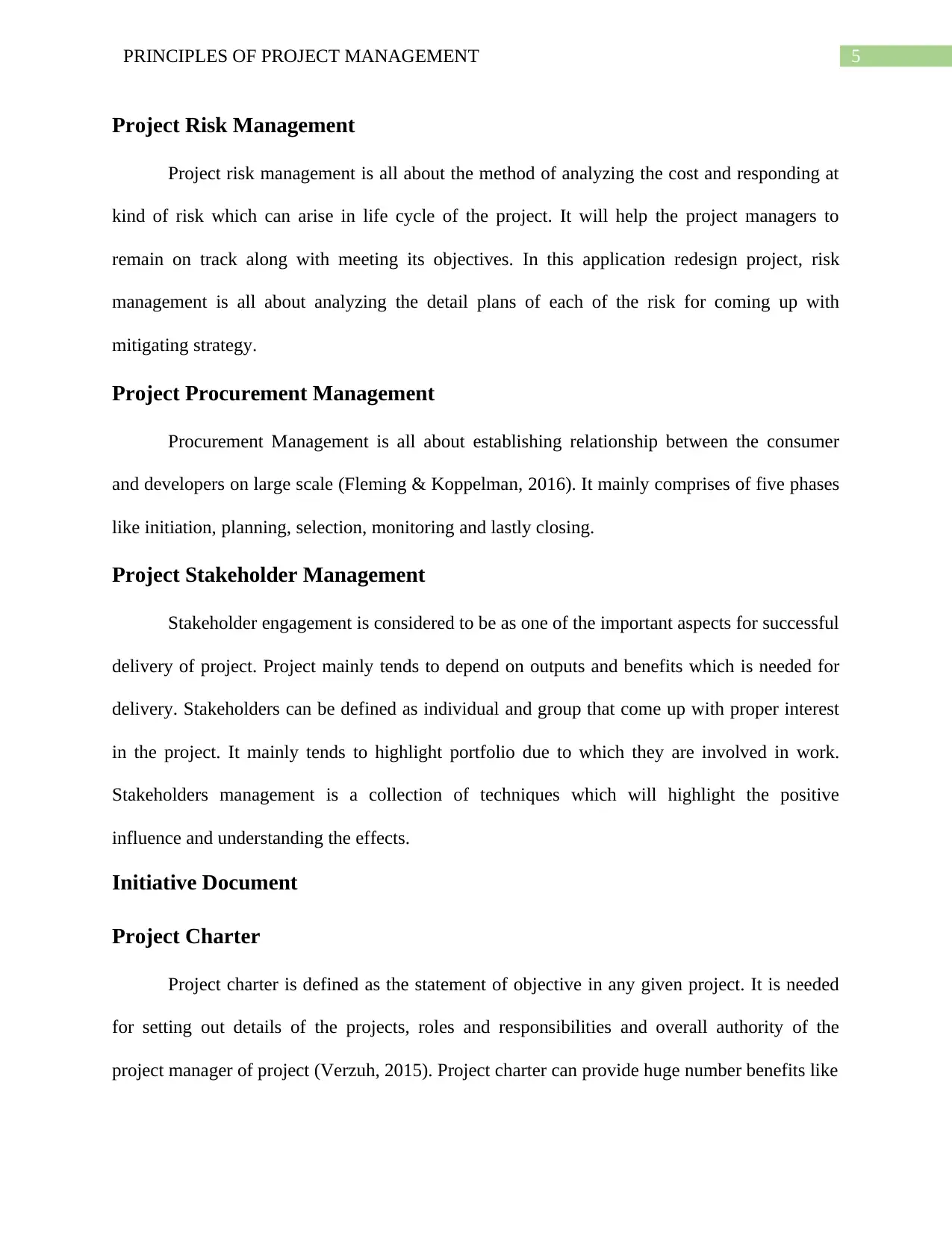
5PRINCIPLES OF PROJECT MANAGEMENT
Project Risk Management
Project risk management is all about the method of analyzing the cost and responding at
kind of risk which can arise in life cycle of the project. It will help the project managers to
remain on track along with meeting its objectives. In this application redesign project, risk
management is all about analyzing the detail plans of each of the risk for coming up with
mitigating strategy.
Project Procurement Management
Procurement Management is all about establishing relationship between the consumer
and developers on large scale (Fleming & Koppelman, 2016). It mainly comprises of five phases
like initiation, planning, selection, monitoring and lastly closing.
Project Stakeholder Management
Stakeholder engagement is considered to be as one of the important aspects for successful
delivery of project. Project mainly tends to depend on outputs and benefits which is needed for
delivery. Stakeholders can be defined as individual and group that come up with proper interest
in the project. It mainly tends to highlight portfolio due to which they are involved in work.
Stakeholders management is a collection of techniques which will highlight the positive
influence and understanding the effects.
Initiative Document
Project Charter
Project charter is defined as the statement of objective in any given project. It is needed
for setting out details of the projects, roles and responsibilities and overall authority of the
project manager of project (Verzuh, 2015). Project charter can provide huge number benefits like
Project Risk Management
Project risk management is all about the method of analyzing the cost and responding at
kind of risk which can arise in life cycle of the project. It will help the project managers to
remain on track along with meeting its objectives. In this application redesign project, risk
management is all about analyzing the detail plans of each of the risk for coming up with
mitigating strategy.
Project Procurement Management
Procurement Management is all about establishing relationship between the consumer
and developers on large scale (Fleming & Koppelman, 2016). It mainly comprises of five phases
like initiation, planning, selection, monitoring and lastly closing.
Project Stakeholder Management
Stakeholder engagement is considered to be as one of the important aspects for successful
delivery of project. Project mainly tends to depend on outputs and benefits which is needed for
delivery. Stakeholders can be defined as individual and group that come up with proper interest
in the project. It mainly tends to highlight portfolio due to which they are involved in work.
Stakeholders management is a collection of techniques which will highlight the positive
influence and understanding the effects.
Initiative Document
Project Charter
Project charter is defined as the statement of objective in any given project. It is needed
for setting out details of the projects, roles and responsibilities and overall authority of the
project manager of project (Verzuh, 2015). Project charter can provide huge number benefits like
⊘ This is a preview!⊘
Do you want full access?
Subscribe today to unlock all pages.

Trusted by 1+ million students worldwide
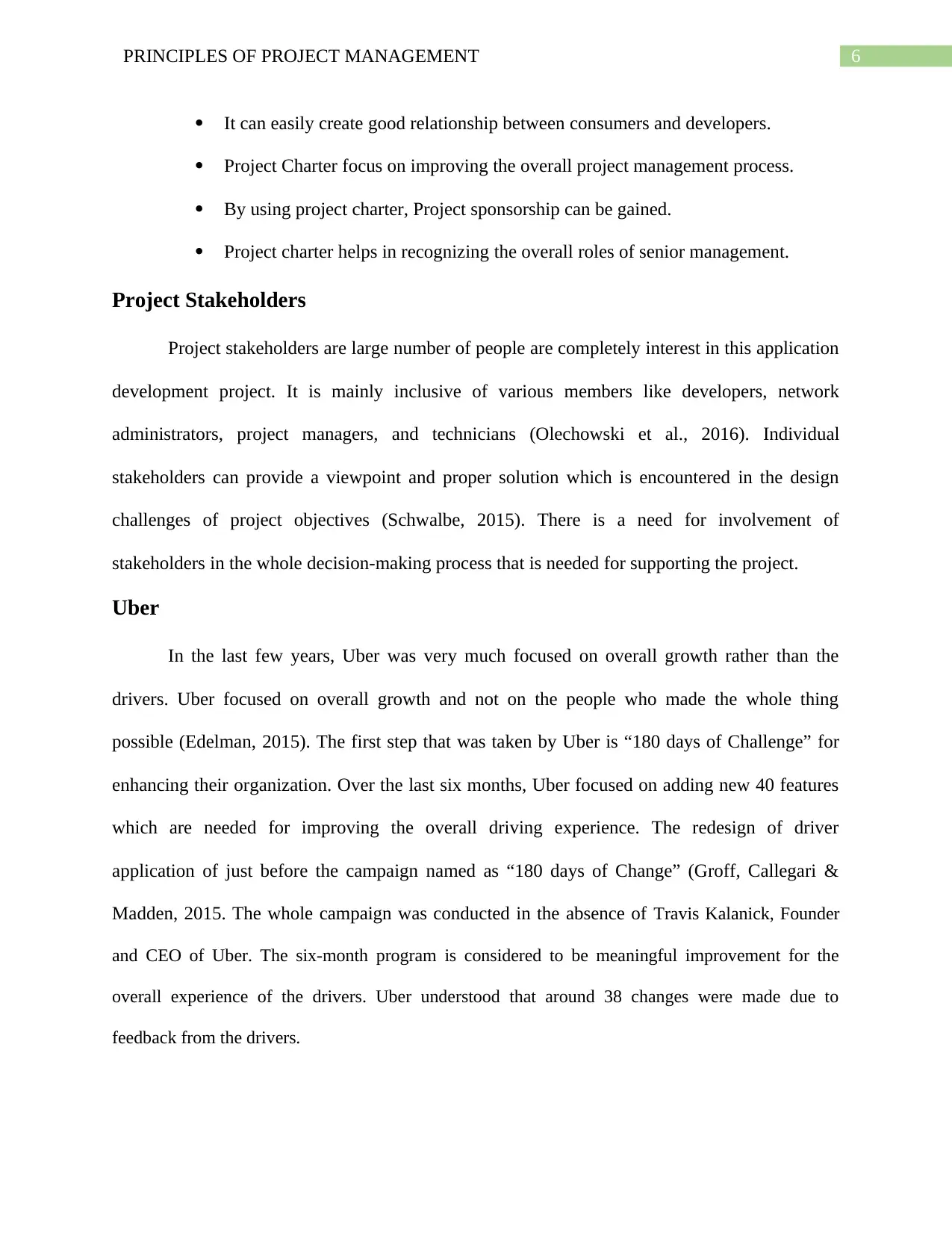
6PRINCIPLES OF PROJECT MANAGEMENT
It can easily create good relationship between consumers and developers.
Project Charter focus on improving the overall project management process.
By using project charter, Project sponsorship can be gained.
Project charter helps in recognizing the overall roles of senior management.
Project Stakeholders
Project stakeholders are large number of people are completely interest in this application
development project. It is mainly inclusive of various members like developers, network
administrators, project managers, and technicians (Olechowski et al., 2016). Individual
stakeholders can provide a viewpoint and proper solution which is encountered in the design
challenges of project objectives (Schwalbe, 2015). There is a need for involvement of
stakeholders in the whole decision-making process that is needed for supporting the project.
Uber
In the last few years, Uber was very much focused on overall growth rather than the
drivers. Uber focused on overall growth and not on the people who made the whole thing
possible (Edelman, 2015). The first step that was taken by Uber is “180 days of Challenge” for
enhancing their organization. Over the last six months, Uber focused on adding new 40 features
which are needed for improving the overall driving experience. The redesign of driver
application of just before the campaign named as “180 days of Change” (Groff, Callegari &
Madden, 2015. The whole campaign was conducted in the absence of Travis Kalanick, Founder
and CEO of Uber. The six-month program is considered to be meaningful improvement for the
overall experience of the drivers. Uber understood that around 38 changes were made due to
feedback from the drivers.
It can easily create good relationship between consumers and developers.
Project Charter focus on improving the overall project management process.
By using project charter, Project sponsorship can be gained.
Project charter helps in recognizing the overall roles of senior management.
Project Stakeholders
Project stakeholders are large number of people are completely interest in this application
development project. It is mainly inclusive of various members like developers, network
administrators, project managers, and technicians (Olechowski et al., 2016). Individual
stakeholders can provide a viewpoint and proper solution which is encountered in the design
challenges of project objectives (Schwalbe, 2015). There is a need for involvement of
stakeholders in the whole decision-making process that is needed for supporting the project.
Uber
In the last few years, Uber was very much focused on overall growth rather than the
drivers. Uber focused on overall growth and not on the people who made the whole thing
possible (Edelman, 2015). The first step that was taken by Uber is “180 days of Challenge” for
enhancing their organization. Over the last six months, Uber focused on adding new 40 features
which are needed for improving the overall driving experience. The redesign of driver
application of just before the campaign named as “180 days of Change” (Groff, Callegari &
Madden, 2015. The whole campaign was conducted in the absence of Travis Kalanick, Founder
and CEO of Uber. The six-month program is considered to be meaningful improvement for the
overall experience of the drivers. Uber understood that around 38 changes were made due to
feedback from the drivers.
Paraphrase This Document
Need a fresh take? Get an instant paraphrase of this document with our AI Paraphraser
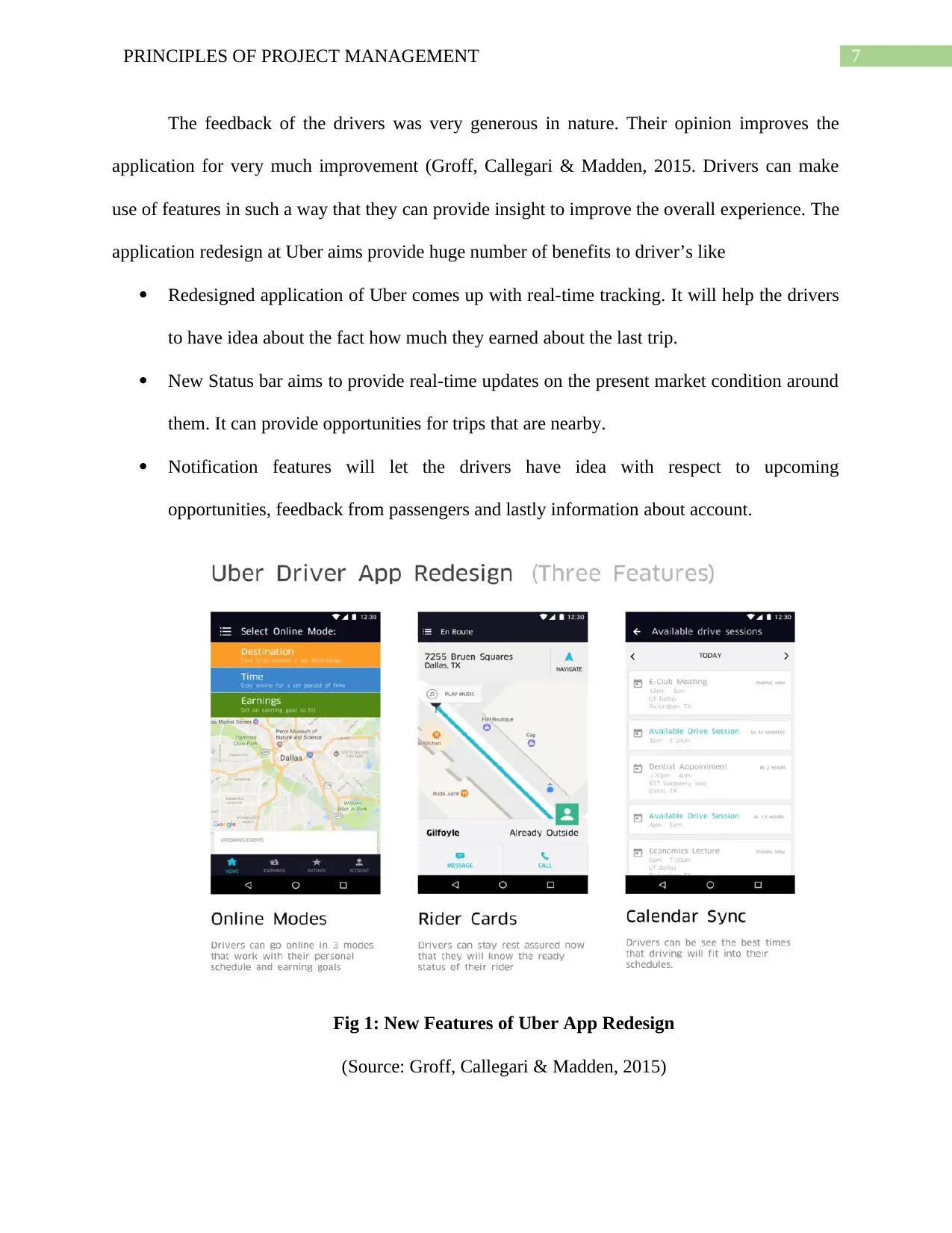
7PRINCIPLES OF PROJECT MANAGEMENT
The feedback of the drivers was very generous in nature. Their opinion improves the
application for very much improvement (Groff, Callegari & Madden, 2015. Drivers can make
use of features in such a way that they can provide insight to improve the overall experience. The
application redesign at Uber aims provide huge number of benefits to driver’s like
Redesigned application of Uber comes up with real-time tracking. It will help the drivers
to have idea about the fact how much they earned about the last trip.
New Status bar aims to provide real-time updates on the present market condition around
them. It can provide opportunities for trips that are nearby.
Notification features will let the drivers have idea with respect to upcoming
opportunities, feedback from passengers and lastly information about account.
Fig 1: New Features of Uber App Redesign
(Source: Groff, Callegari & Madden, 2015)
The feedback of the drivers was very generous in nature. Their opinion improves the
application for very much improvement (Groff, Callegari & Madden, 2015. Drivers can make
use of features in such a way that they can provide insight to improve the overall experience. The
application redesign at Uber aims provide huge number of benefits to driver’s like
Redesigned application of Uber comes up with real-time tracking. It will help the drivers
to have idea about the fact how much they earned about the last trip.
New Status bar aims to provide real-time updates on the present market condition around
them. It can provide opportunities for trips that are nearby.
Notification features will let the drivers have idea with respect to upcoming
opportunities, feedback from passengers and lastly information about account.
Fig 1: New Features of Uber App Redesign
(Source: Groff, Callegari & Madden, 2015)
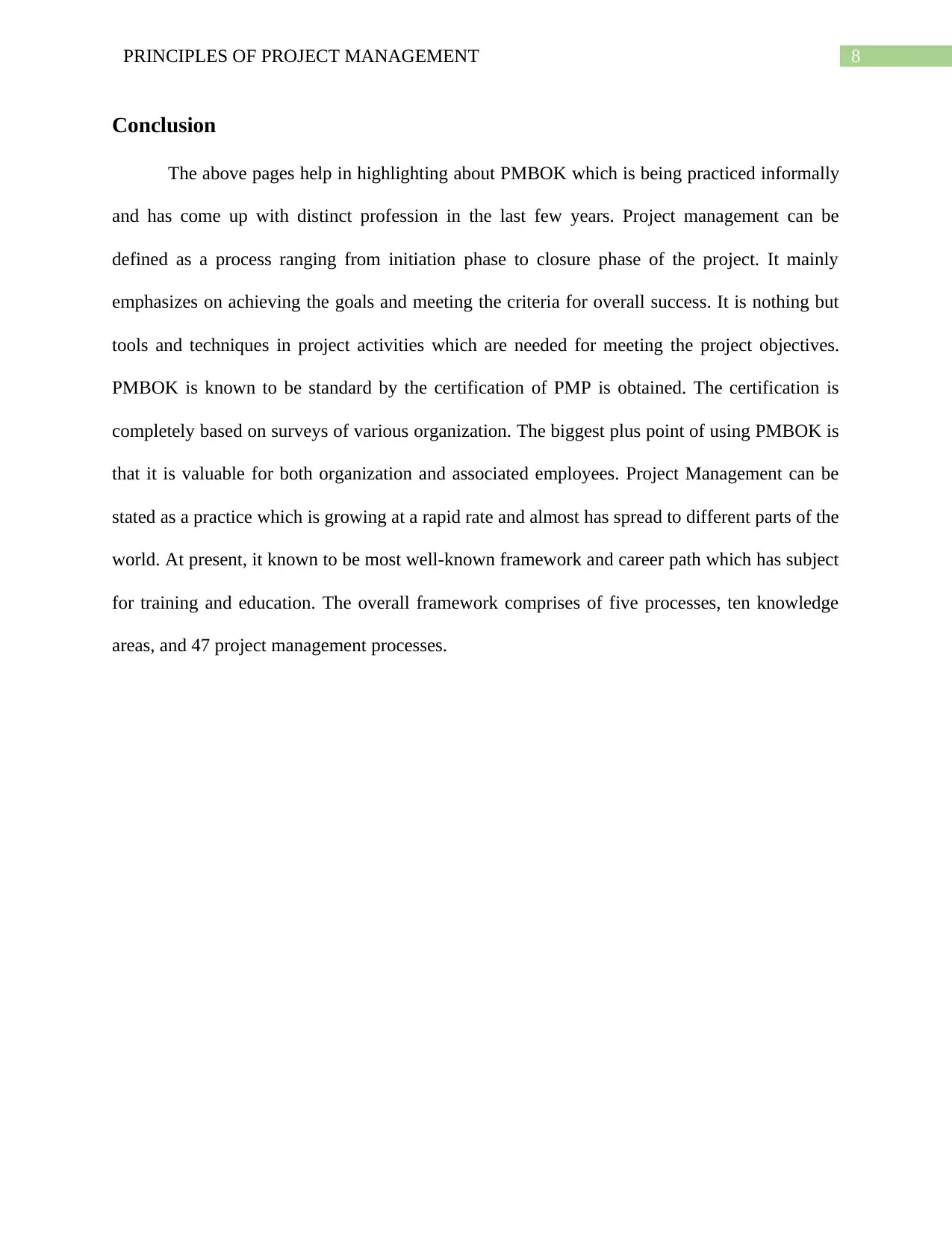
8PRINCIPLES OF PROJECT MANAGEMENT
Conclusion
The above pages help in highlighting about PMBOK which is being practiced informally
and has come up with distinct profession in the last few years. Project management can be
defined as a process ranging from initiation phase to closure phase of the project. It mainly
emphasizes on achieving the goals and meeting the criteria for overall success. It is nothing but
tools and techniques in project activities which are needed for meeting the project objectives.
PMBOK is known to be standard by the certification of PMP is obtained. The certification is
completely based on surveys of various organization. The biggest plus point of using PMBOK is
that it is valuable for both organization and associated employees. Project Management can be
stated as a practice which is growing at a rapid rate and almost has spread to different parts of the
world. At present, it known to be most well-known framework and career path which has subject
for training and education. The overall framework comprises of five processes, ten knowledge
areas, and 47 project management processes.
Conclusion
The above pages help in highlighting about PMBOK which is being practiced informally
and has come up with distinct profession in the last few years. Project management can be
defined as a process ranging from initiation phase to closure phase of the project. It mainly
emphasizes on achieving the goals and meeting the criteria for overall success. It is nothing but
tools and techniques in project activities which are needed for meeting the project objectives.
PMBOK is known to be standard by the certification of PMP is obtained. The certification is
completely based on surveys of various organization. The biggest plus point of using PMBOK is
that it is valuable for both organization and associated employees. Project Management can be
stated as a practice which is growing at a rapid rate and almost has spread to different parts of the
world. At present, it known to be most well-known framework and career path which has subject
for training and education. The overall framework comprises of five processes, ten knowledge
areas, and 47 project management processes.
⊘ This is a preview!⊘
Do you want full access?
Subscribe today to unlock all pages.

Trusted by 1+ million students worldwide
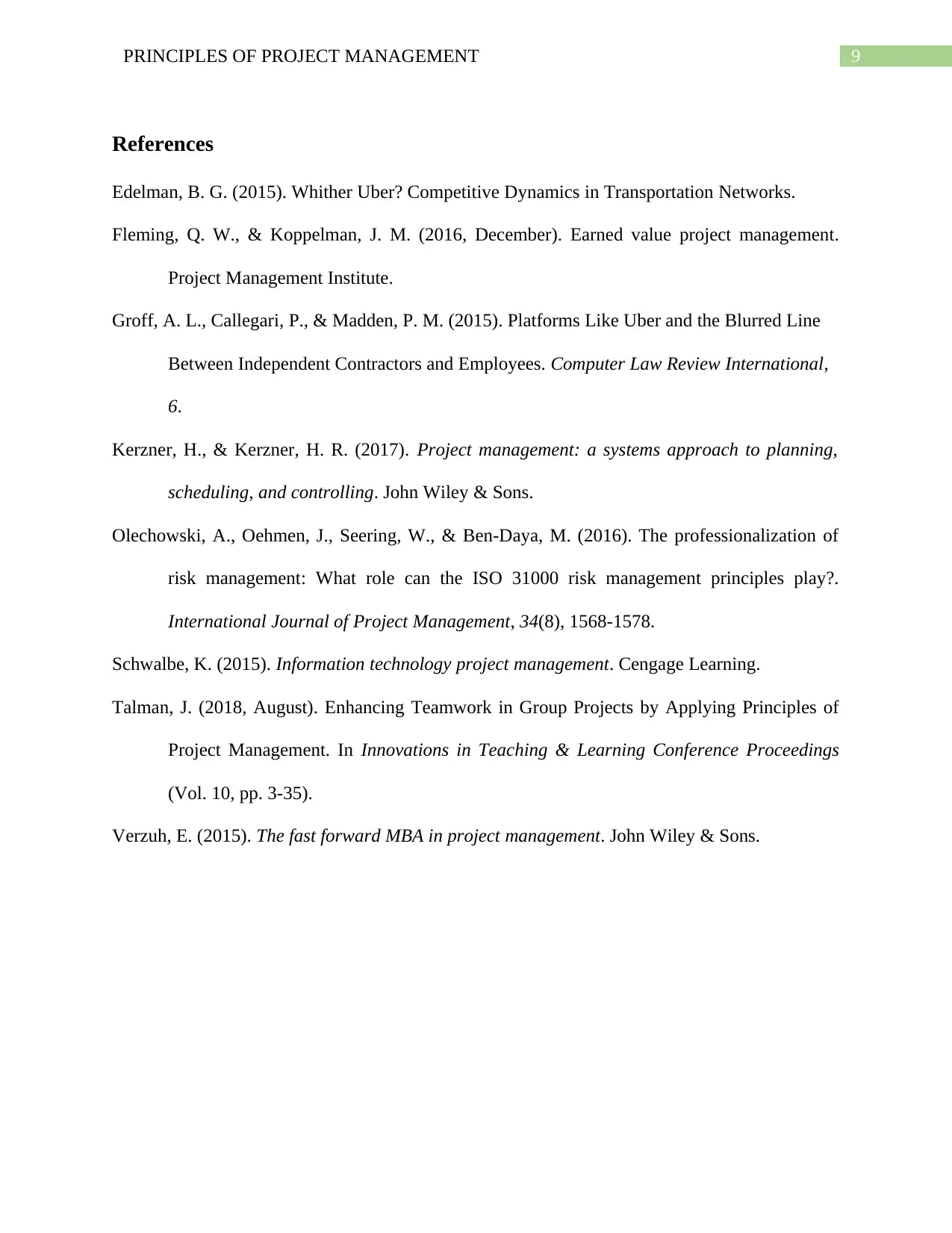
9PRINCIPLES OF PROJECT MANAGEMENT
References
Edelman, B. G. (2015). Whither Uber? Competitive Dynamics in Transportation Networks.
Fleming, Q. W., & Koppelman, J. M. (2016, December). Earned value project management.
Project Management Institute.
Groff, A. L., Callegari, P., & Madden, P. M. (2015). Platforms Like Uber and the Blurred Line
Between Independent Contractors and Employees. Computer Law Review International,
6.
Kerzner, H., & Kerzner, H. R. (2017). Project management: a systems approach to planning,
scheduling, and controlling. John Wiley & Sons.
Olechowski, A., Oehmen, J., Seering, W., & Ben-Daya, M. (2016). The professionalization of
risk management: What role can the ISO 31000 risk management principles play?.
International Journal of Project Management, 34(8), 1568-1578.
Schwalbe, K. (2015). Information technology project management. Cengage Learning.
Talman, J. (2018, August). Enhancing Teamwork in Group Projects by Applying Principles of
Project Management. In Innovations in Teaching & Learning Conference Proceedings
(Vol. 10, pp. 3-35).
Verzuh, E. (2015). The fast forward MBA in project management. John Wiley & Sons.
References
Edelman, B. G. (2015). Whither Uber? Competitive Dynamics in Transportation Networks.
Fleming, Q. W., & Koppelman, J. M. (2016, December). Earned value project management.
Project Management Institute.
Groff, A. L., Callegari, P., & Madden, P. M. (2015). Platforms Like Uber and the Blurred Line
Between Independent Contractors and Employees. Computer Law Review International,
6.
Kerzner, H., & Kerzner, H. R. (2017). Project management: a systems approach to planning,
scheduling, and controlling. John Wiley & Sons.
Olechowski, A., Oehmen, J., Seering, W., & Ben-Daya, M. (2016). The professionalization of
risk management: What role can the ISO 31000 risk management principles play?.
International Journal of Project Management, 34(8), 1568-1578.
Schwalbe, K. (2015). Information technology project management. Cengage Learning.
Talman, J. (2018, August). Enhancing Teamwork in Group Projects by Applying Principles of
Project Management. In Innovations in Teaching & Learning Conference Proceedings
(Vol. 10, pp. 3-35).
Verzuh, E. (2015). The fast forward MBA in project management. John Wiley & Sons.
1 out of 10
Related Documents
Your All-in-One AI-Powered Toolkit for Academic Success.
+13062052269
info@desklib.com
Available 24*7 on WhatsApp / Email
![[object Object]](/_next/static/media/star-bottom.7253800d.svg)
Unlock your academic potential
Copyright © 2020–2025 A2Z Services. All Rights Reserved. Developed and managed by ZUCOL.




